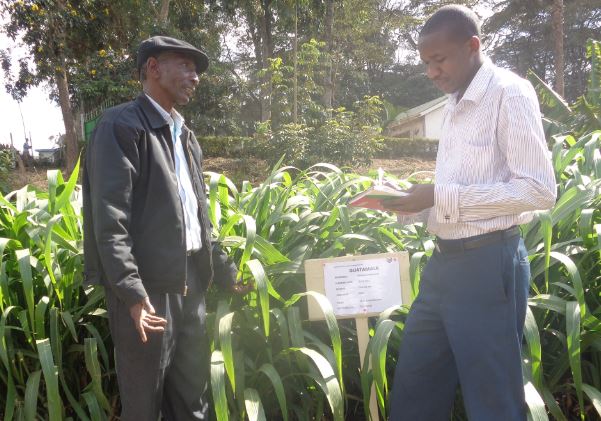Evans Muugu, 63, is no ordinary farmer. The retired police officer has struck gold in Guatemala grass, an alternative fodder crop that withstands Napier stunt and head smut diseases. The fodder is fed to livestock to improve milk production.
Muugu retired in 1982 before working as a security guard in various city hotels in Nairobi including Safari Park & May Fair hotels. When Farmbiz Africa visited Evans who was one of the exhibitors at the 2017 Nairobi International Trade Fair, he had already sold his entire stock for the day making a profit 20,000 within half a day.
READ ALSO: Brachiaria grass rescues farmer's cow from drought
He started planting the grass in early 2000’s after being introduced to by a friend from Egerton University, Nakuru. With an initial 9 root splits, Evans planted the grass and has since expanded it to 2 acres of his farm where he propagates the grass for sale.
Evans Muugu (left), a Guatemala grass farmer at the 2017 Nairobi International Trade Fair at Jamhuri grounds, Nairobi. PHOTO/ZABLON OYUGI
“To plant the grass, you cut root splits to 20-30 cm and plant one root split per hole” says Evans. According to the Kenya Agricultural and Livestock Production, you should apply either one soda bottle-top per hole (one bag TSP/DAP per acre) or 2 handfuls of farm yard manure/compost manure per hole at planting. The soil should be covered firmly.
READ ALSO: Super grass cuts greenhouse gases, tripling yields
Muugu has collaborated with Wambugu farm in Nyeri to propagate splits for farmers in that area. He sells 6 splits of the grass at Ksh. 100 making 15000 to 20000 on a good agricultural show. “The advantage of Guatemala grass, whose origin is believed to be India is that it is hairless and drought resistant, when overgrown there is no waste, as it doesn’t harden like Napier grass” said Evans. It also has high crude protein content and hence can enhance energy in livestock.
Muugu has 5 cows, 3 of which are lactating; each cow gives him an average of 25 liters per day. Initially without the Guatemala grass, he used to get an average of 15 liters per cow.
READ ALSO: Farmers embrace Rhodes grass to fight climate change
How to Manage Guatemala Grass
- Weed whenever weeds appear
- First harvest is at 3-4 months after planting
- Harvest by cutting
- Maintain a stubble height of 10 cm to encourage re-growth
- Subsequently harvest at 6-8 weeks (11/2 to 2 months) intervals
- After every 2nd harvest, apply 2-3 bottle tops of CAN per stool or 2 bags per acre, or apply 2 handfuls of FYM/compost per stool (4 tonnes FYM/compost per acre)
How to utilize Guatemala grass
- Well-managed Guatemala grass produces 5-7 tonnes of dry matter per acre in a year. This is enough to feed one dairy cow per year
- Harvest and chop 2-3 cm pieces and feed them fresh to livestock
- When plenty, make silage for dry season feeding
Advantages of Guatemala grass
- It grows well in many regions of Kenya
- It is easily rotated with other crops
- It produces high forage (75% of the forage produced by Bana Napier variety)
Evans Muugu can be reached on +254 727 794 065.

















Comments powered by CComment